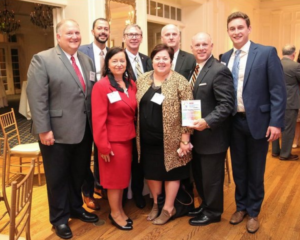Are Monroe and Union County a hotspot for international corporate culture? Maybe.
Chris Platé, executive director of Monroe-Union County Economic Development, says the city and county agency has for years cast a wide international net for economic development prospects. The recruiters consistently attend the Paris Air Show and the Farnborough International Airshow in the United Kingdom. The agency also ensured the Charlotte-Monroe Executive Airport became a U.S. Customs point of entry, the only general aviation airport in the Carolinas to have one.
By Ken Elkins – Senior Staff Writer, Charlotte Business Journal – Sept 28, 2018

“As a result, we have 20-plus companies from all over the globe, including Austria, India, Japan, Sweden, Taiwan, Colombia, Germany, the U.K. and France,” Platé says.
Union County is home to Achem Industry Americas from Taiwan, a producer of pressure-sensitive films and tapes; Cyril Bath Co. from France, a manufacturer of stretch-form machines for aerospace; Aries Manufacturing, also from France, a producer of stretch-formed titanium aerostructure components; and Glenmark Pharmaceuticals from India, which produces tablet and topical medications.
Here are Platé’s responses to our questions about international investment and trade.
Is more foreign investment a goal for Monroe-Union County Economic Development?
Yes, we seek to have a healthy balance of growth between new companies and existing ones, domestic firms and foreign-based. The Monroe speculative buildings are designed to entice companies from other countries. They are built more substantial than typical industrial buildings, with heavier load capacity in the roof, thicker walls, many windows — all characteristics that increase a building’s energy and operational efficiency.
What can you do to increase the amount of FDI in Union County?
We constantly reach out directly into the targeted markets. Europe is a big place and it takes some research to know where to go so you have a better chance of securing investment. We have also contracted with a firm to represent our county over there and provide lead generation into our desired markets.
What have your efforts been to attract international aerospace companies?
We focus on smaller, niche companies that are suppliers to original equipment manufacturers like Boeing and Airbus. Our goal is to not make the airplane, but to produce everything that is on one. There are so many companies in aerospace and precision manufacturing in Europe that need to make a base of operations in the United States. So being close to the OEMs, with Charlotte Douglas International and our own U.S. Customs facility at the Charlotte-Monroe Executive Airport, our community is well-positioned to serve these small to midsize foreign firms.
What is FDI looking for in a community that domestic companies wouldn’t necessarily be looking for in Union?
They are looking for openness to other cultures. Since Union County has grown faster than any other county in the region for almost two decades, the population is mostly from other areas like New York, California, Illinois. Many are also from Europe and India. This along with the superior school system is a magnet.

Are you pleased with the availability of spec buildings in Union?
The city of Monroe has limited capacity to develop buildings and parks. They have elected to build one at a time.
Once the building is sold, the government process to design, bid and build a building is very long compared to the private sector. Unfortunately, the private sector has not constructed buildings of the size we need to attract substantial companies. Monroe has been the sole provider of these buildings and has had great success. In fact, every spec building has been sold to a foreign-based firm.
Is that why Monroe-Union County Economic Development decided to do their own spec buildings?
Yes, we can design and construct a building that is heavier than the private sector would provide, while leaving the building in such a condition that the purchaser can customize the layout as necessary for their process. The buildings are built for manufacturing, not distribution.
For the full article, Click Here

